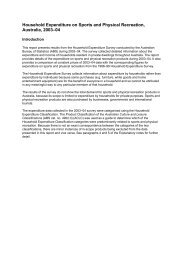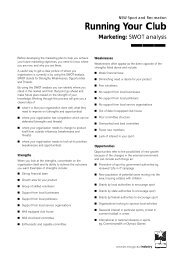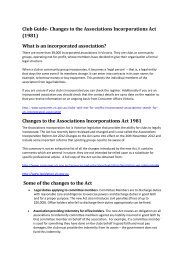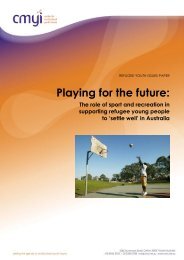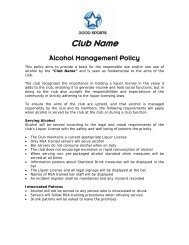School Playing Fields: Planning and Design Guidance - VicSport
School Playing Fields: Planning and Design Guidance - VicSport
School Playing Fields: Planning and Design Guidance - VicSport
Create successful ePaper yourself
Turn your PDF publications into a flip-book with our unique Google optimized e-Paper software.
Figure 11: Optimum pitch provision for rangeof secondary school sizes.Pitch Pitches to Min. arearequirement be provided required (ha)1 Grass Football Size 1 0.92 Grass Football Size 1 1.8Rugby Size 13 Grass Football Size 1 <strong>and</strong> 2 2.5Rugby Size 14 Grass Football Size 1 <strong>and</strong> 2 3.2Rugby Size 1 <strong>and</strong> 21 SGP SGP (Multi-Purpose) 1.71 Grass Rugby Size 11 SGP SGP (Multi-Purpose) 2.52 Grass Football Size 1Rugby Size 11 SGP SGP (Multi-Purpose) 3.23 Grass Football Size 1 <strong>and</strong> 2Rugby Size 11 SGP SGP (Multi-Purpose) 3.94 Grass Football Size 1 <strong>and</strong> 2Rugby Size 1 <strong>and</strong> 22 SGP SGP (Football) 4.54 Grass SGP (Hockey)Football Size 1 <strong>and</strong> 2Rugby Size 1 <strong>and</strong> 2The above recommendations are based on atypical balance between pitch sports, with footballthe most popular activity <strong>and</strong> all hockey takingplace on synthetic grass. Other factors to bear inmind are as follows:• For schools which concentrate more on hockeyor rugby, changes to the mix of pitches (althoughnot to the overall numbers) may be required.This is most likely to be applicable to schoolsconcentrating on rugby, with one or more ofthe football pitches being replaced by rugby.• If shinty is played, one or more of the grassfootball or rugby pitches should be replacedby a shinty pitch. When marking an U12 orU14 9-a-side pitch on a full-size pitch, centreit on the same spot with the goal line runningthrough the penalty spot of the full-size pitch.• Club hockey is almost wholly played onsynthetic grass <strong>and</strong> only where a second SGPis provided is there a real opportunity to furtherincrease hockey provision.• For those schools with a strong hockeyprogramme the SGP may be predominantlyor even wholly for hockey use although it will inmost cases still make sense to ensure that theSGP is suitable for a range of school activities.Minimum areas required for pitchprovisionThe minimum area required for each level of pitchprovision is simply the total area taken up by thepitches, their safety margins <strong>and</strong> a 9m strip alongone side to allow lateral movement of the pitchto reduce wear <strong>and</strong> tear at the most heavily usedareas. Although there is some flexibility in pitchdimensions <strong>and</strong> the lateral strip (not in the safetymargins), in many cases the shape <strong>and</strong>topography of the site will mean a larger area isneeded to provide the required number of pitches.In addition, multi-courts or hard-surfaced playareas will require further space. These facilitiesshould not be considered as teaching spacesbut can make an important contribution toinformal physical activity by pupils, therebyreducing wear <strong>and</strong> tear on the grass pitches.If cricket is played, the provision of a syntheticwicket or grass cricket square, perhaps insertedbetween winter sports pitches <strong>and</strong> using part ofthem as the outfield, will require yet further spacealthough this option may restrict the flexibility ofthe playing fields, especially on smaller sites.Siting of playing fieldsThe siting of playing fields is important <strong>and</strong>should be decided at an early stage in theplanning of a school. There are a number offactors that should be taken into considerationas follows:• Access• Topography• Gradients• Orientation• Flexibility• Training areas• Seasonal layouts• Safety <strong>and</strong> convenience• Other activitiesAccessMany school pitches <strong>and</strong> courts are used by thecommunity <strong>and</strong> there should be a clearly identifiedroute from the school entrance or car park to bothchanging facilities <strong>and</strong> to the playing facilitiesthemselves. The entrance <strong>and</strong> reception area willbe the principal means of controlling the facility <strong>and</strong>the activities taking place. The relationshipbetween this area <strong>and</strong> the main school entrancemust be carefully planned to ensure that security<strong>and</strong> child protection issues are properly addressed.There should be easy access from the physicaleducation block/changing facilities to the outdoorpitches <strong>and</strong> courts. Where possible, this should bevia an area of hard surface playground or properlysurfaced paths. Routes to natural grass pitchesshould not cross other games areas, particularlySGPs <strong>and</strong> MUGAs, in order to avoid mud beingdeposited on them. For the same reason, accessroutes to SGPs <strong>and</strong> MUGAs should not involvecrossing over natural grass areas.All access routes should be designed with therequirements of disabled users in mind <strong>and</strong> shouldcomply with the requirements of the DisabilityDiscrimination Act. <strong>Planning</strong> of the school siteshould consider the possible need for emergencyvehicle access <strong>and</strong> the access <strong>and</strong> storagerequirements of maintenance plant <strong>and</strong> vehicles.TopographyThe topography of a playing field site is animportant consideration. The larger <strong>and</strong> flatterthe playing field, the more flexible it will be.Construction costs can be minimised if cut <strong>and</strong> fillis limited. In the interests of safety, banks withgradients greater than 1:3 should be avoided.Steep banks can also cause drainage problemsfor the l<strong>and</strong> at their base <strong>and</strong> scouring of surfaces.Gradients of grass playing surfacesTo aid surface drainage, a slight gradient acrossthe direction of play is desirable. Gradients of1:60 to 1:80 (a maximum of 1:40 if existinggradients are a constraint) across the line of playwill be suitable for winter games pitches <strong>and</strong> thecricket outfield. Pitches should be level alongthe line of play. Cricket squares should be level inthe direction of play although a maximumgradient of 1:100 is acceptable as is a crossgradient of 1:60 to 1:80.<strong>School</strong> <strong>Playing</strong> <strong>Fields</strong> 32<strong>School</strong> <strong>Playing</strong> <strong>Fields</strong> 33



